Document 13578566
advertisement
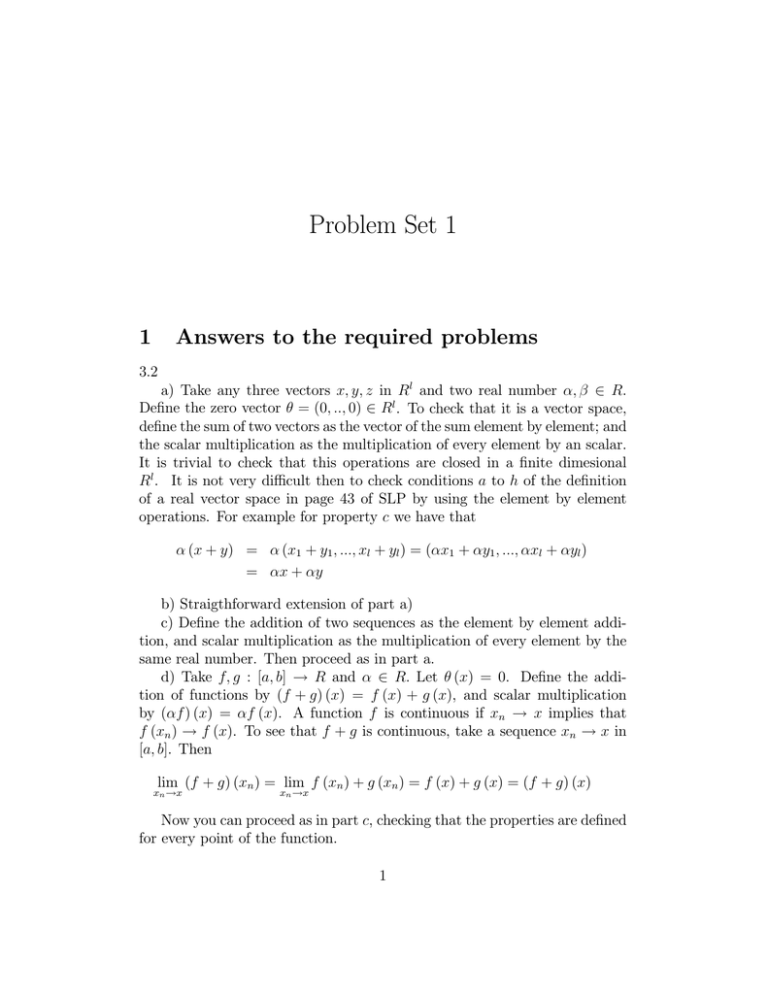
Problem Set 1
1
Answers to the required problems
3.2
a) Take any three vectors x, y, z in Rl and two real number α, β ∈ R.
Define the zero vector θ = (0, .., 0) ∈ Rl . To check that it is a vector space,
define the sum of two vectors as the vector of the sum element by element; and
the scalar multiplication as the multiplication of every element by an scalar.
It is trivial to check that this operations are closed in a finite dimesional
Rl . It is not very difficult then to check conditions a to h of the definition
of a real vector space in page 43 of SLP by using the element by element
operations. For example for property c we have that
α (x + y) = α (x1 + y1 , ..., xl + yl ) = (αx1 + αy1 , ..., αxl + αyl )
= αx + αy
b) Straigthforward extension of part a)
c) Define the addition of two sequences as the element by element addition, and scalar multiplication as the multiplication of every element by the
same real number. Then proceed as in part a.
d) Take f, g : [a, b] → R and α ∈ R. Let θ (x) = 0. Define the addition of functions by (f + g) (x) = f (x) + g (x), and scalar multiplication
by (αf ) (x) = αf (x). A function f is continuous if xn → x implies that
f (xn ) → f (x). To see that f + g is continuous, take a sequence xn → x in
[a, b]. Then
lim (f + g) (xn ) = lim f (xn ) + g (xn ) = f (x) + g (x) = (f + g) (x)
xn →x
xn →x
Now you can proceed as in part c, checking that the properties are defined
for every point of the function.
1
e) Take the vectors (0, 1) and (1, 0). Then (1, 0) + (0, 1) is not in the unit
circle.
f) Choose α ∈ (0, 1). Then 1 ∈ I but α1 6∈ I. Violates the definition of
vector space
g) Let f : [a, b] → R+ . Take α < 0, then αf ≤ 0, so does not belong to
the set of nonnegative functions.
3.3.
a) Take three different integers x, y,and z. The non-negative property
holds trivially for the absolute value. Also
ρ (x, y) = |x − y| = |y − x| = ρ (y, x)
Finally
ρ(x, y) = |x − y| ≤ |x − z| + |z − y| ≤ ρ (x, z) + ρ (z, y)
b) First, ρ (x, y) ≥ 0, and with equality only when x = y. It is also true
that ρ (x, y) = ρ (y, x).
Finally to show that ρ (x, y) ≤ ρ(x, z) + ρ(z, y), notice that you have to
consider three cases, when z = y, z = x and when z 6∈ {x, y}. For the first
two cases the triangle inequality holds with equality. For the last one it holds
with inequality ρ (x, y) < 2 for all x, y.
c) Take three functions x (t) , y (t), and z (t). The first two properties
of the metric are immediate from the definition of absolute value. Notice
also that x, y continuous in [a, b] implies that the functions are bounded.
The proposed metric is then real valued (not extended real). To prove the
triangle inequality let
ρ (x, z) = max |x (t) − z (t)| = max |x (t) − y (t) + y (t) − z (t)|
t∈[a,b]
t∈[a,b]
≤ max {|x (t) − y (t)| + |y (t) − z (t)|}
t∈[a,b]
≤ max |x (t) − y (t)| + max |y (t) − z (t)| = ρ (x, y) + ρ (y, z)
t∈[a,b]
t∈[a,b]
d) Very similar to c.
e) Similar to a.
f) The first two properties come from the absolute value plus f (0) = 0,
and f is strictly increasing (there is only one zero).
2
To see the triangle inequality, let
ρ (x, y) = f (|x − y|) = f (|x − z + z − y|)
By strictlt increasing f we have
f (|x − z + z − y|) ≤ f (|x − z| + |z − y|)
And by concavity we have
f (|x − z| + |z − y|) ≤ f (|x − z|) + f (|z − y|) = ρ (x, z) + ρ (z, y)
3.4.
a) The norm is non-negative comes from the definition of the square root
of sum of squares. The second one, ||αx|| = |α| ||x||, is implied by
X
X
x2i = α2 ||x||
(αxi )2 = α2
||αx||2 =
To prove the triangle inequality we follow :
||x + y||2 =
X
(xi + yi )2 =
By Cauchy-Schwartz we have that
X
x2i + 2
X
xi yi +
X
yi2 ≤
X
X
P
x2i + 2
X
xi yi +
X
yi2
P
P
1/2
xi yi ≤ [( x2i ) ( yi2 )] so
xi2 + 2
h³X
xi2
´ ³X
yi2
´i1/2
+
X
yi2
= ||x||2 + 2 ||x|| ||y|| + ||y||2 = (||x|| + ||y||)2
This implies that ||x + y|| ≤ ||x|| + ||y||.
b),c) are very similar exploiting the absolute value properties.
d) The proposed norm is non-negative and is real valued (bounded sequences). The first property, notice that ||x|| = 0 only if for all k, xk = 0.
The second property we have ||αx|| = supk |αxk | = |α| supk |xk | = |a| ||x||.
For the triangle inequality we have
||x + y|| = sup (|xk + yk |) ≤ sup (|xk | + |yk |) ≤ sup |xk | + sup |yk |
k
k
k
= ||x|| + ||y||
3
k
e) Proceed as in part d.
f) Proceed as in part d.
3.5.
a) By the triangle inequality we know that
ρ (x, y) ≤ ρ (xn , x) + ρ (xn , y)
given that xn → x, and xn → y, the right hand side can be made as small
as wanted, implying that ρ (x, y) = 0 and x = y.
b) If xn → x, then for any ε, we can find N such that ρ (xn1 , x) < ε/2
for n1 > N . The distance between to xn1 and xn2 with n2 > N is then
ρ (xn1 , xn2 ) ≤ ρ (xn1 , x) + ρ (xn2 , x) = ε for all n1 , n2 > N . (which is the
Cauchy definition).
c) Pick an ε, then there exists an N such that for n1 > N we have that
ρ (xn1 , xn2 ) < ε. Then ρ (xn1 , 0) ≤ ρ (xn1 , xN ) + ρ (xN , 0) = ε + ρ (xN , 0). Let
M = maxn<N {ρ (xn , 0)}. So we have then that for all n,
ρ (xn , 0) ≤ max{ε + ρ (xN , 0) , M } < ∞ for all n
so the sequence is bounded.
d) The fact that xn → x implies that every subsequence converges is easy.
To show that if every subsequence converges to x, then {xn } converges to x
we need to show that if xn does not converge to x, then there is a subsequence
that does not converge to x. We can construct such a sequence by showing
that if {xn } does not converge, for any ε, and for any N1 we can find an
k1 > N such that |xk1 − x| > ε. Let N2 > k1 and can find a k2 such that
|xk2 − x| > ε and so on , and construct a sequence of {xki } that is always
bounded away from x by ε.
3.6.
a) The metric in 3.3a is complete. Just choose ε < 1, such that |xn − xm | <
ε = 1. This implies that xn = xm = x. Where x is the limit of the sequence.
The 3.3b metric is similar.
The metric in 3.4a is complete. To show that, notice that if {xn } is a
Cauchy sequence under the norm, then each of the kth elements of xn are
also a Cauchy sequence. Given that the real line is¡ complete,
¢ each sequence
k
1
k
of kth elements converges to some x . Define x = x , ..., x . Compute the
P i
2
(xn − xi ) . Given that every
distance from xn to x. This is ρ (xn , x)2 =
4
xin → xi , then ρ (xn , x)2 → 0 which proves the limit result. The metric in
3.4b and 3.4c is similar.
For 3.4d. Let xkn be the kth element of the n sequence. The fact©that
ª
k
a sequence of sequences is Cauchy (under
the
norm)
implies
that
x
n
© ª
is Cauchy as well. This implies that xkn converges to some xk . Let
x = {x1 , x2 , ....}. ©It ¡is easy¢ª
to see that ρ (xn , x) ≤ ρ (xn , xm ) + ρ (xm , x) ≤
k
k
ρ (xn , xm ) + supk ρ xm , x . Given that xkm → xk and {xn } is Cauchy, we
can make the left hand side of the inequality as small as possible, implying
that ρ (xn , x) → x.
3.4.e. The proof was done in class for more general space.
The 3.3c is not complete. Just analyze the limit of for example xn (t) =
1 + an t as an → 0 with an > 0. This limit is just xn (t) = 1, which is not
strictly increasing.
3.3e is not complete: rational sequences can converge to irrational numbers.
In 3.4.f, just think of the counter example for a = 0,b = 1 and xn (t) = tn .
In this case, ρ (xn , xm ) → 0, but the limit of xn (t) is discountinuos at t = 0.
For the case of 3.3.c replacing with ”non-decreasing” we can construct
the limit function point by point as before. Now, we have to show that the
limit function is non-decreasing, to do that suppose that is not, that the
Cauchy sequence of {fn } converges to f , but for some t0 > t we have that
f (t) − f (t0 ) > ε. Then
0 < ε < f (t) − f (t0 ) = f (t) − fn (t) + [fn (t) − fn (t0 )] + fn (t0 ) − f (t0 )
≤ 2 ||f − fn || + fn (t) − fn (t0 )
Given that f → fn , it has to be the case that fn (t) − fn (t0 ) > ε, a
contradiction of non-decreasing property of fn .
b) Since S 0 is closed in S, any convergent sequence in S 0 converges in
S 0 . Given that any Cauchy sequence in S converges in S (by completeness),
implies that any Cauchy sequence in S 0 converges, and hence converges in
S0.
3.9. See that
¡
¢
¡
¢
ρ (T n v0 , v) ≤ ρ T n v0 , T n+1 v0 + ρ T n+1 v0 , v =
¢
¢
¡
¡
= ρ T n v0 , T n+1 v0 + ρ T n+1 v0 , T v
¡
¢
≤ ρ T n v0 , T n+1 v0 + βρ (T n v0 , T v)
5
Rearranging term we get the inequility we need.
3.13.
a) Same as part b. with f (x) = x.
b) Choose any x. Since 0 ∈ Γ (x), Γ (x) is non-empty. Choose any
y ∈ Γ (x) and consider the sequence xn → x. Let γ ≡ y/f (x) ≤ 1 and
yn = γf (xn ). So yn ∈ Γ (xn ). Then by continuity of f we have that limyn =
γ lim f (xn ) = γf (x) = y. Hence f is l.h.p.c. at x.
Given x, Γ (x) is compact valued. Take arbitrary sequences xn → x and
yn ∈ Γ (xn ). Given that {xn } converges, this implies that {xn } is bounded.
This implies that {yn } is bounded as well. Because any bounded sequence
of real numbers has a convergent subsequence there exists a convergent subsequence {ynk }. Let y = lim ynk . Now we need to show that lim ynk ≤ f (x).
Suppose no, then for some N , we have that ynk − f (x) > ε for all nk > N .
This implies then that ynk − f (xnk ) > 2ε for all nk > M > N . But this is
impossible, because ynk ∈ Γ (xnk ).
c) Proceed coordinate by coordinate as in b)
4.3)
a) Let v (x0 ) be finite. Since v satisfies the FE, as shown in the proof of
Theorem 4.3, for every x0 ∈ X and every ε > 0 there exists an −
x ∈ Π (x0 )
→
such that
¡ ¢
ε
x + β n+1 v (xn+1 ) +
v (x0 ) ≤ un −
→
2
Taking the limit as n → ∞ this gives
¡ ¢
¡ ¢ ε
ε
n+1
x
+
lim
sup
β
v
(x
)
+
≤
u
x +
v (x0 ) ≤ u −
n+1
→
−
→
2
2
n→∞
¡ ¢
Given that u −
x ≤ v∗ (x0 ) this gives us that
→
v (x0 ) ≤ v ∗ (x0 ) + ε/2
and hence v (x0 ) ≤ v ∗ (x0 ) for all x0 .
If v (x0 ) = −∞, the result is immediate. If v (x0 ) = ∞ the proof is along
the lines of the last part of theorem 4.3
6
b) By the argument in theorem 4.3 we have that
¡ ¢
v (x0 ) ≥ un −
x + β n+1 v (xn+1 )
→
¡ 0¢
¡
¢
¡ 0¢
¡ ¢
x + lim β n v x0n+1 = un −
x ≥u −
x
v (x0 ) ≥ lim un −
→
→
→
n→∞
n→∞
For all −
x ∈ Π (x0 ). This implies that
→
v (x0 ) ≥ v∗ (x0 ) =
¡ ¢
sup u −
x
→
x ∈Π(x0 )
−
→
and together with the result in part a), we have that v = v∗ .
4.4)
a) Let K be a bound on F and M be a bound on f.Then
(T f ) (x) ≤ K + βM , for all x ∈ X
Hence T : B (X) → B(X).
We show now that T is a contraction mapping.
Monotonicity :
Let f, g with f ≤ g. Then
(T f ) (x) =
max F (x, y) + βf (y) = F (x, y ∗ ) + βf (y ∗ )
y∈Γ(x)
≤ F (x, y ∗ ) + βg(y ∗ ) ≤ (T g) (x)
where y ∗ ∈ arg max F (x, y) + βf (y)
Discounting: It is easy to show that T (f + a) (x) = (T f ) (x) + βa.
So, T is a contraction. There is a unique fixed point. Γ (x) is non-empty
and finite-valued for all x implies that the optimal policy correspondence is
non-empty; and the maximum is always attained.
b) Similar to part (a)
c) Note that
wn (x) = (Thn wn ) (x)
≤ max [F (x, y) + βwn (y)]
¡
¢
= (T wn ) (x) = Thn+1 wn (x)
So we have that wn ≤ T wn . Monotonicity of Thn implies that Thn wn ≤
Thn (T wn ) = Th2n wn . Iterating in this operator we have that
T wn ≤ ThNn+1 wn
7
But wn+1 = limN →∞ ThNn+1 wn . Hence T wn ≤ wn+1 . And
w0 ≤ T w0 ≤ w1 ≤ T w1 ≤ ... ≤ T wn ≤ v
By the contraction mapping,
||wn − v|| ≤ ||T wn−1 − v|| ≤ β ||wn−1 − v||
≤ β ||T wn−2 − v|| ≤ β 2 ||wn−2 − v||
≤ β n ||w0 − v||
and hence wn → v as n → ∞.
8
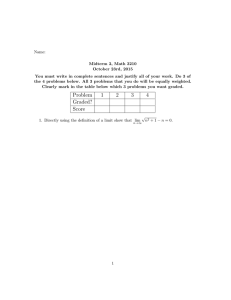

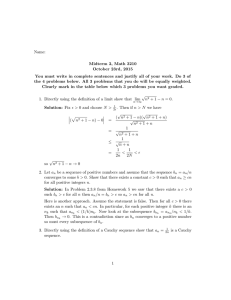
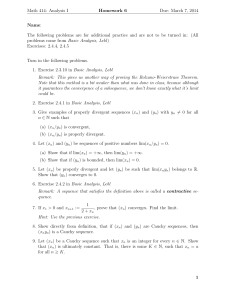
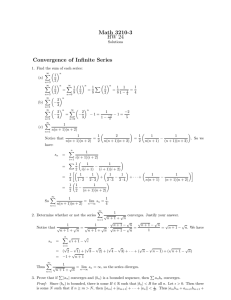
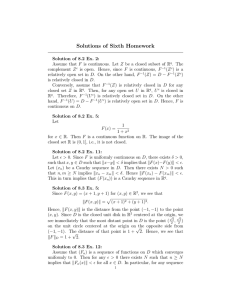
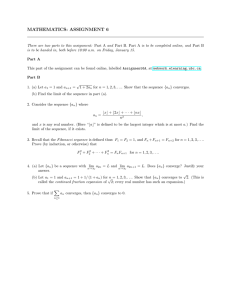
![SOLUTION OF HW3 September 24, 2012 1. [10 Points] Let {x](http://s2.studylib.net/store/data/011168953_1-36e45820ffc71e8ec27ae652a93485b4-300x300.png)